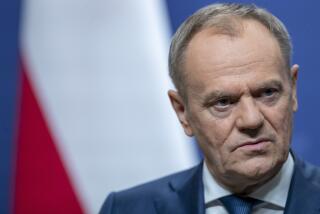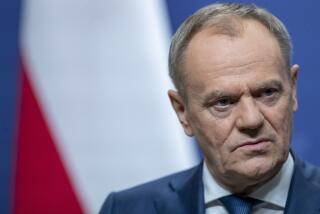Poland Becomes Journeyâs End for Migrants
DEBAK, Poland â Abba Mohammed Mohedeenshire has been on the run for six years, fleeing his native Somalia during a bloody civil war that left most of his family and tiny tribe bloodied or dead.
He first escaped across the border to Kenya. He then hitched a ride to Syria. From there, he paid $1,000 to a friend, who arranged for him to be smuggled into Russia.
Exhausted and penniless, the 29-year-old auto mechanic was arrested this fall sneaking across the border from Belarus into Poland. He says he has reached the end of his journey.
âI would like to start learning Polish and begin to make a future for myself,â said Mohedeenshire, who is enrolled in a language course at a refugee center here. âIâm done going to other countries. It is time to make things better.â
Poland may seem like an unlikely destination for a young African refugee in search of the European promised land, but it has become a welcome âsecond bestâ for thousands of migrants unable to settle farther west in Germany--which has cracked down on asylum seekers--and the rest of Western Europe.
Long a transit country for illegal migration from East to West, Poland is emerging as a settling point as well.
Officials estimate that 100,000 to 200,000 illegal immigrants are living here, a small number compared to Southern California but a remarkable about-face for a country better known for producing illegal immigrants, not attracting them. About 10,000 legal immigrants move here each year as well, according to researchers.
*
At the same time, migration of Poles has reached an equilibrium for the first time in 50 years, authorities say, with as many people of Polish origin returning to the country as those choosing to leave.
âOur country offers a lot to people who decide to stay,â said Elzbieta Przychodzen, director of the Debak refugee center on the outskirts of Warsaw, the largest of 10 such centers across Poland. âPeople who go to the West and encounter huge difficulties can take advantage of our situation here and do quite well.â
Some immigrants, turned back from Germany, are sticking it out in Poland, hoping that it will be easier to move westward once the European Union expands in this direction. Others have been enticed by the countryâs economy, which is the largest in Central Europe and stronger than any in the former Soviet Union. Still others end up here by chance: Several dozen Sri Lankans were deposited at the Warsaw train station last year by their smuggler guide, who announced that they had arrived in Berlin.
âFor migrants, especially the most dynamic among them, Poland offers easier chances to earn money than countries like Germany, where they have to compete with millions, not thousands, of migrants,â said Marek Okolski, director of the Center for Migration Research at Warsaw University. âFor people with specific skills, Poland is still a land of opportunity.â
The influx of illegal Armenians has grown so large that authorities will soon institute visa requirements for Armenia, the first former Soviet republic to face such curbs.
A growing Vietnamese community, its numbers swollen by migrant laborers fleeing Asian crime syndicates in eastern Germany, has also prompted new visa restrictions for Vietnam.
Polish authorities say Moldova, a small, impoverished former Soviet republic, is next on the blacklist. Last year, more than 1,000 Moldovans were caught trying to cross the Polish border illegally, second only to Romanian Gypsies.
âIf we want to integrate into the European Union, we have to show our goodwill in fighting illegal immigration,â said Maciej Kuczynski, deputy director of the Polish Department for Migration and Refugee Affairs. âIf there is any risk that Poland will be a hole in the European border, we will not get in. We are very aware of that.â
*
Polish border guards apprehended about 15,000 illegal immigrants last year, and since 1994 more than 14,000 people have been returned to Poland after unsuccessful attempts to enter Germany from this country. As Germans and other Western Europeans have tightened border controls in recent years, applications for refugee status in Poland have quadrupled, with about 4,000 expected this year.
âWe want to go to Germany, but we want to do it legally,â said a 22-year-old Sri Lankan refugee who had walked 10 hours from Ukraine to Poland with several friends, one of whom later had to have several toes amputated because of frostbite. âPoland will be OK. We would like to get some documents so we can work.â
Polish authorities say their biggest challenge is plugging the illegal immigration hole without drying up the cross-border flow of traders and consumers--both legal and illegal--who provide a huge boost to the Polish economy. Last year, 82 million foreigners crossed into Poland legally, the majority of them on shopping excursions.
The mammoth Stadion Dziesieciolecia flea market in Warsaw, crammed into a rundown soccer stadium near the riverâs edge, has grown into the countryâs fifth-largest export business, with more than $550 million in sales last year. It is a rarity to hear Polish spoken amid the chorus of foreign-language transactions at the stadium, which economists estimate provides a livelihood for 60,000 people.
On the western border with Germany, roadside merchants sell more than 1 million garden gnomes a year to German bargain hunters, while laid-off farm workers in eastern Poland have launched thriving furniture enterprises aimed at cross-border customers from the former Soviet Union. Meanwhile, it is difficult to visit a building site in Warsaw where the language of choice is not Russian.
âWe are being very careful not to take measures that kill the border commerce,â Kuczynski said. âWe see this as a very positive trend.â
Even with the shift in migration, it would be an exaggeration to say Poland is evolving into an American-style melting pot of ethnicities. The largest immigrant group, the Ukrainians, numbers about 100,000, a tiny fraction of the countryâs 38 million inhabitants.
But researchers say the immigration trend is snowballing and is already changing the face of the country.
In Warsaw, Vietnamese sidewalk kitchens compete with kiosks offering traditional Polish sausages and potato dumplings. At the cityâs biggest black market for day laborers, the gardeners, house painters and craftspeople hail from across the former Soviet Bloc.
âWe canât talk of a multiethnic Poland,â Okolski said. âBut what is significant is there is now a network bringing other migrants into the country, so there has been a multiplier effect. The number of [immigrant] communities only goes in the hundreds, not the thousands, but it is spreading.â
The phenomenon is too new and too modest to have spawned a significant backlash among Poles, although extremist political parties--eager to cash in on latent Polish xenophobia--have stirred the waters in some areas. Most troubles have evolved over turf wars, particularly among traders at the Stadion Dziesieciolecia and among competing organized-crime groups.
Przychodzen, the refugee center director, said there has also been resistance among local school officials when refugees are placed in classes because of the disruption to other students.
Polish authorities have dispersed the refugee centers across the country so that âall of Polish society gets used to this new situation,â she said.
More to Read
Sign up for Essential California
The most important California stories and recommendations in your inbox every morning.
You may occasionally receive promotional content from the Los Angeles Times.










